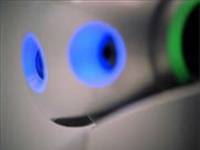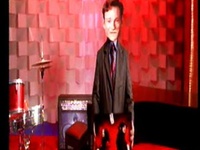"Heard ’Em Say"
Kanye West
Kanye West is a consummate collaborator. His tag-team sessions with Jay-Z, Common, and Jamie Foxx have produced some of the most incendiary singles of the decade:
hits like “Izzo (H.O.V.A.),” “Go,” and “Gold Digger” topped Billboard charts and invigorated moribund radio playlists.
In light of those formidable successes, it is surprising that Kanye’s most recent collaboration, with legendary animator Bill Plympton (“I Married A Strange Person”), is such a dismal failure. Their collaboration, a music video for “Heard ‘Em Say,” Kanye’s latest single from this summer’s hit album “Late Registration,” has none of the flair of either artist’s best work.
Plympton’s animation is a frustratingly literal rendition of Kanye’s lyrics: West’s stream-of-conscious verses are dutifully translated into cartoon vignettes, but the gonzo flourishes that characterize Plympton’s style are lamentably absent.
Adding insult to injury, the animated portions of the video are interspersed with even blander live-action footage of Kanye and accompanying singer Adam Levine (of Maroon 5 infamy) delivering lackluster vocal performances before a bare white background.
The most likely source of the video’s mediocrity is a creative power struggle between Plympton and West. When Kanye debuted the video on BET’s taste-making music video program, “106 & Park,” he claimed sole director’s credit, making only a passing reference to Plympton’s contribution. Plympton’s obvious and trite interpretation of West’s song indicates that he was probably kept on a very short creative leash.
Rumor has it that music video auteur Michel Gondry has also directed a version of “Heard ’Em Say” that is due for release near Christmas. Let’s hope that Kanye blesses the Frenchman with a little more artistic liberty, equality, and fraternity.
—Bernard L. Parham
"Hell Yes"
Beck
It’s a heartening sign that Beck can upstage his own robots.
Dude always gets hella flak from haters who say that his lyrics sound like they came out of some computerized random hobo lyric generator. People also rightfully cry foul for his played-out “do the Robot like it’s 1983!” dance routine.
But in the video for this oft-maligned “Guero” track (not to be confused with the video for the eight-bit-style remix of this song, which came out earlier this year), even Japan’s smoothest exports can’t stop the raw power of a human. Well, a hologram of a human, in this case.
Apparently, Sony invented four robots that can dance. They’re a foot high or so, look like the main character from the film “Short Circuit,” and can be programmed to do all manner of silly shakes.
So, of course, Beck’s people hired all four of them to dance in front of a camera. They move slowly on a little stage while a bunch of people watch. It’s…not all that inspiring.
Didn’t we invent robots to do more interesting things than move glacially and hold red fans? Damn Asimov’s Three Laws of Robotics; shouldn’t robots be threatening our lives by now? Robots really blew their chances—America was so afraid of them like 10 years ago, but they’re pretty robo-passé.
Then, a hologram of Beck appears above them, and all is made well, somehow. He flashes in and out of existence, looking like the communications systems from “Star Wars,” and is sometimes replaced momentarily by Christina Ricci (who lends guest vocals to the track).
It feels like he’s the hidden-message programmer from the climax of “2001: A Space Odyssey”…you know, when Dave shuts down HAL 9000, and there’s the screen of the guy that pops up, telling Dave what the real reason for the mission was?
Well, it feels like that. Except I didn’t cry at the end of this video, and I weep like a little girl whenever I see HAL getting shut down.
Seriously, though—what ever happened to people being afraid of robots?
Have we let our guard down prematurely? After all, we may not always be able to count on Beck to save us from the androids and their dancing ways.
—Abe J. Riesman
"The Denial Twist"
The White Stripes
At the end of Michel Gondry’s video for the White Stripes’ “The Denial Twist,” Conan O’Brian ’85 laments: “My head’s getting bigger…squarer…more like a cube,” as Meg White comforts him. This makes about as much sense as anything else that occurs in the video.
Fans of rock’s favorite pseudo-siblings may recall that the White Stripes played Late Night with Conan O’Brian for a week straight in 2003. The video plays out like a fever-dream retelling of one of their performances.
All the real elements are there: in one uninterrupted shot, they play, they do a couch-interview segment in which they present O’Brian with a large cardboard version of his head, and they go home and watch themselves on TV, where he visits them (maybe this part isn’t so realistic).
This relatively straightforward sequence is literally warped: the video plays with proportion and scale, stretching the Stripes vertically and horizontally, and using tricks of perspective to make them alternately tower over each other, not to mention the occasional use of midgets to portray O’Brian and passers-by on the street. Also, Meg’s giant foot from the future crushes a piano.
The first time around, the video is fun to watch for its sheer dizzying surrealistic kick. On a second viewing it becomes impossible not to try to piece together just how Gondry (here in his fourth video collaboration with the White Stripes) manages to pull it off in one shot. Digital trickery aside, it looks like the filming must have required some very oddly-shaped rooms, trapdoors, and Rockettes-level choreography.
The video is ultimately a non sequitur: most of the video has nothing to do with the song, and many of the events depicted within have nothing to do with each other. This doesn’t really matter, though; the video is too cool and strange to let a little thing like reality get in its way.
—Elisabeth J. Bloomberg
Read more in Arts
Light Touches Sparkle in 'You Never Can Tell'















